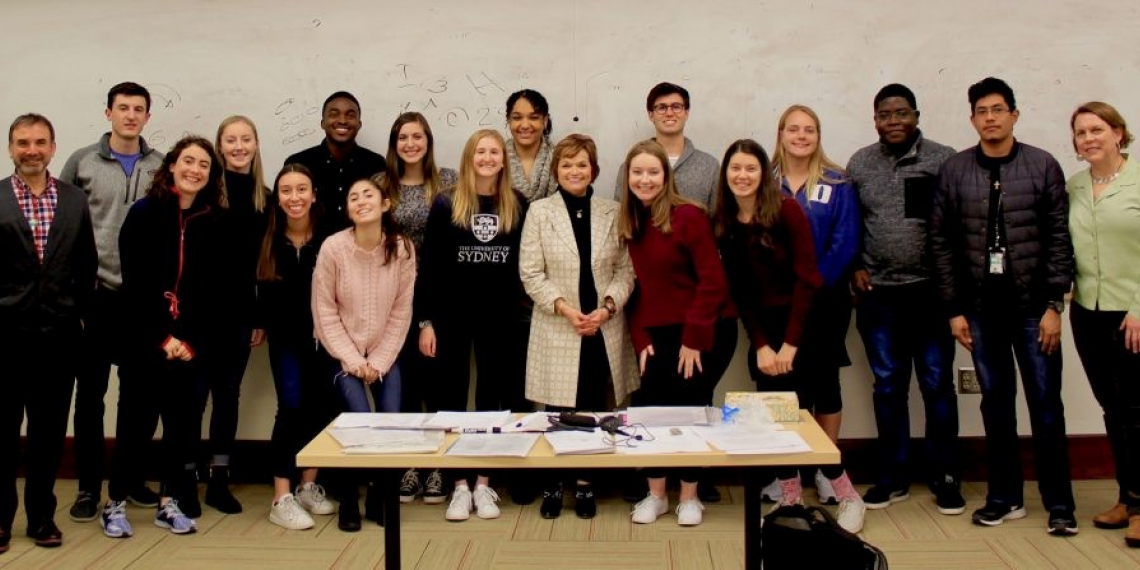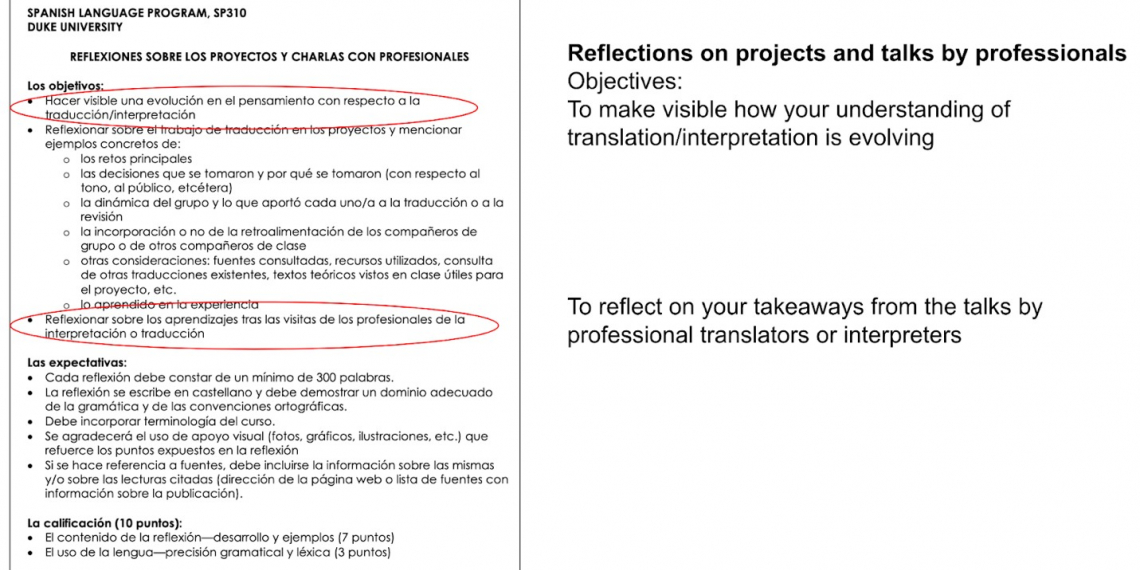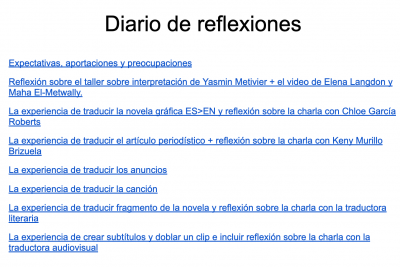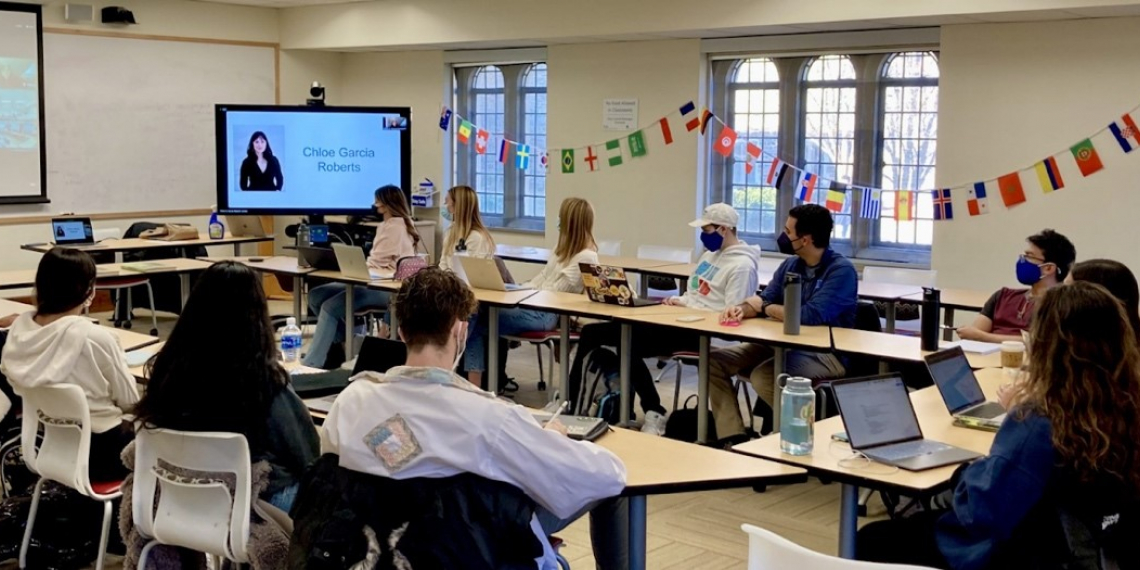Mise en abyme: a reflection on reflections
“We do not learn from experience … we learn from reflecting on experience.”
John Dewey
We have co-taught Spanish 310 (Translating English-Spanish, Spanish-English) for several years. Over time we have continued to define and refine many aspects of the course. Some fundamental challenges remain, however, and that’s why we applied for the Bacca Fellowship.
1. How can we process the critical reflections efficiently and provide students meaningful feedback?
2. To prompt or not to prompt?
3. How can we track the evolution of each student's thought over the course of the semester?
What aspect of our course did we work on in the Bacca Fellows program?
A defining activity in our course are the critical reflections students write in Spanish after having experienced the process of translating a specific genre. We are looking for evidence of an evolution of our students’ thinking on translation (and interpretation). However, we believe we could better align the design of and feedback on these critical reflections with student learning outcomes in a more meaningful and sustainable way. After reflecting on the reflections, we identified 4 sticking points, and with the assistance of our cohort of Bacca Fellows, we have articulated some key takeaways.
1. How can we process the critical reflections efficiently and provide students meaningful feedback?
We want the reflections to be sustained, but still sustainable. Asking students to spell out and reflect on their takeaways and what they mean at regular intervals means they are producing a lot of complex text that seems to demand a complex response. We have taught together for a long time and are accustomed to criteria-based grading, so agreeing on a score for the work produced is not difficult. The stickier part is what kind of feedback to give, how much, and how to craft it with a co-professor to get it back in a timely manner. With such rich reflections, that at their best are each student "thinking aloud with an audience," it is challenging to respond with thoughtful and tailored feedback for each post, since it takes us instructors a lot of time and energy.
Key takeaway: Framing the feedback in terms of the DEAL model is the ideal, since it provides a clear path to encourage the translator/reflector to develop and pull out the nuances and significance of what they are learning. |
2. To prompt or not to prompt?
We have created (and revised) general guidelines for all the reflections, in part out of a desire not to limit where they might go or what they might say. With this approach, some students have met or surpassed our expectations. For others, however, their reflections are on occasion vague and tend to recycle the same things they have said about the previous genre.
Key takeaway: We plan to experiment in a future iteration of the class, and tailor the prompt for each reflection. Narrowing the scope and clarifying what our expectations are at defined points along the trajectory, may well have the effect of drawing out a visible line of evolution of thought, as well as guiding students to produce more developed and intentional content, in addition to facilitating our processing and giving feedback on the reflections. |
3. How can we track the evolution of each student's thought over the course of the semester?
When we first began teaching the class, each student had their own blog page in WordPress, and we asked students to read each other’s entries and discuss. Having students read each other’s reflections and comment amongst themselves did not seem to lead to deeper thinking beyond what they had achieved in the drafting of the entry, and the conversations became perfunctory.
Indeed, students’ meeting to compare their translations and discussing their criteria for making decisions were really the catalyst for changes in their thinking, rather than their meeting to compare their already packaged takeaways from the activity.
We then asked students to turn in each reflection as an assignment, scrapping the idea of a blog altogether. Having students submit each reflection separately, though, meant that tracking any evolution of thought over time became much more difficult, both for us as professors and more especially for the students themselves. While the assignments feature facilitated clear deadlines, grading, and feedback, it also served to silo activity-related epiphanies into discrete, locked-down units.
The design we have been trying this semester, a single, indexed Google Doc for each student, with access granted only to the two professors and to the student, has yielded some promising results. We have dubbed it the Diario de reflexiones (Reflection Journal). This format has made it easier for each student to quickly review what their trajectory has been over the course of the semester.
Key takeaway: We do not assume that the thinking must evolve in any sort of neat linear pattern without any hiccups, but finding an efficient way to display the reflections, so that it's easy to read them as a continuous stream (a journal), facilitates the appreciation of changes over the course of time. |
At the beginning of the semester, the theory and the practice of translation are invariably new and exciting for students. One of the first epiphanies, for example, is grasping the fundamental difference between translation and interpretation, and this distinction (along with its significance) takes many students by surprise. Though every project requires the translation of a new genre, with new rules and new subtleties, the same kind of feeling of learning and progress that occurs at the beginning of the semester, and even mid-semester with some new genres, comes to feel rote, and stale, by the end of the semester. The logistical challenge of the current form of the reflections is also enmeshed with the pedagogical dilemma of how to prevent individual expressions of learning from becoming "dead-ended" to the instructors instead of contributing to the classroom community's learning and reflection.
Key takeaway: Repeating the same format of written reflection, especially in the absence of guided prompts, is likely to yield a rehash of the same thinking, rather than a deepening or critiquing of what the student already thought. It is not realistic to expect the frequency and intensity of discoveries toward the end of the semester as at the beginning. We need something that does not make entering new territory feel like going over the same ground. Besides creating custom prompts, an experiment that we would like to try in the next iteration of the course is planning out a multimodal articulation of reflection, in which we map out a path for reflection that includes individual guided reflections in the journal, students comparing their takeaways in class in pairs or trios, in-class writing to synthesize ideas quickly and without investing a lot of time in revision, and our also making use of a guided group reflection based on what we instructors learned after reading the individual reflections and synthesizing them. The latter could make giving feedback and getting students to deepen their thought a more efficient, dynamic, and stimulating process. Bringing the individual evolution of thought to the classroom in the form of group reflections and more spontaneous exchange, so that the whole class may benefit, also means that we can economize on the written feedback we need to give, and it makes the reflections more dynamic, less repetitive, and more community-building. |
We would like to express our gratitude for the Bacca Fellowship, which provided us the space to reflect on reflections in unparalleled company.
IMAGE CREDIT: Photo by Melissa Simmermeyer and Joan Munné
ABOUT THE AUTHORS:
Melissa Simmermeyer teaches Spanish-language courses at all levels. Besides second-language acquisition, her research interests include assessment, teaching grammar, teaching writing and rhetorical strategies, cultural and sustainability studies, translation, community-based learning, and digital pedagogy (approaching the use of digital tools in courses from a critical perspective).
Joan Munné areas of interest include: Second language acquisition, second Language instruction and assessment, language-learning technologies, teacher training, Spanish variation, language in contact and bilingualism, Spanish in the USA, Spanish for Heritage Speakers, cultural studies, service-Learning pedagogy, etc.







